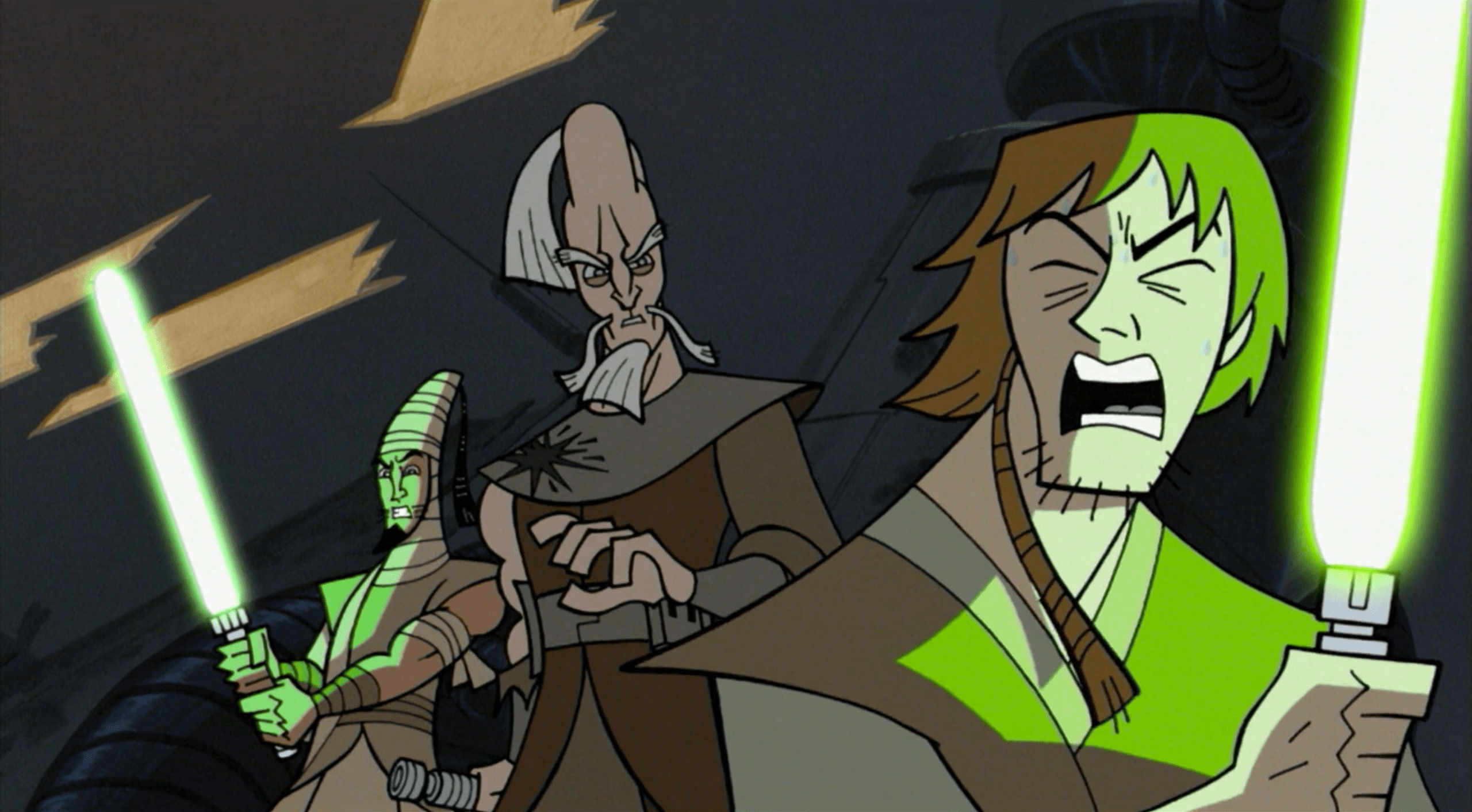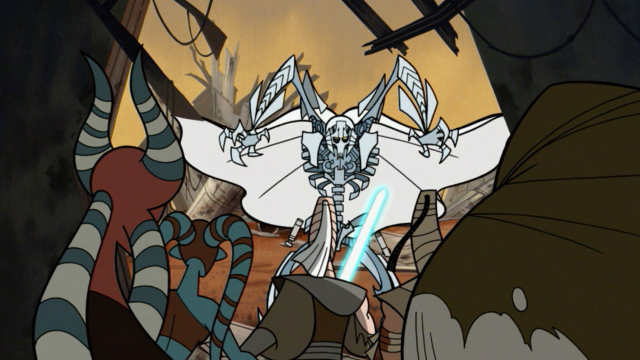Genndy Tartakovsky’s Star Wars Clone Wars micro-series is remembered — deified even — for its action. It is all killer, no filler: the dialogue is spartan, its themes layered but simple. This is Star Wars and you are here for tight, explosive, bombastic action unlike anything the franchise had dared to dream of before, and rarely would after. The series’ arguable apex, its 20th chapter, is no exception.
In the grand tradition of iconic Star Wars hench-villains making their debut in animation, just as Boba Fett had 26 years beforehand, in April 2004 — 17 years ago to this day, in fact — audiences were introduced to the franchise’s next supporting big bad in General Grievous. The Grievous we meet here, beyond aesthetic choices befitting Clone Wars anime-influenced style, is markedly different to the cyborg we would meet on the big screen a year later in Star Wars: Episode III Revenge of the Sith.
[referenced id=”1674535″ url=”https://gizmodo.com.au/2021/02/star-wars-stories-from-tartakovskys-clone-wars-that-should-rejoin-canon/” thumb=”https://gizmodo.com.au/wp-content/uploads/2021/02/24/ava3r2zuhlf2kifpatxs-300×168.png” title=”Star Wars Stories From Tartakovsky’s Clone Wars That Should Rejoin Canon” excerpt=”Dave Filoni has created a vast swath of the Star Wars universe through his Clone Wars and Rebels cartoons, The Mandalorian, and whatever else he has in the works next. He’s been such a driving force in the franchise that it can be hard to remember he didn’t actually make…”]
He didn’t have a cough, not yet at least, to be explained away by the micro-series’ third and final series. His spindly, bone-tinged armour replaced with cool whites and steel tones, thickened to look as menacing as possible. Not here is the cackling, scheming ‘40s serial villain George Lucas would want from Revenge of the Sith’s sinister patsy but instead, a taciturn, ruthless killing machine who wanted one thing and one thing only: the complete extermination of any Jedi that dared cross his path. A take, one could certainly describe with a sense of glee, that was more “badass.” Filed away are many of the more cartoonish, even clumsy shades that would be added to Grievous in Revenge and eventually the 3D CG Clone Wars series that would sweep Tartakovsky’s show out of canon for good. Instead, he was something serious, something violent, something that is, as we rejoiced, all killer and no filler.

Chapter 20 can certainly be remembered like so much of Clone Wars in this way: a nine-minute (bumped up from prior episode’s typical three-to-four-minute runtime) hyper-concentrated dose of action, in which this horrifying figure of cybernetic dread carves a bloody (yet bloodless) path through a squad of Jedi. Lightsabers whirl with frightful precision on both sides, bodies are carved, stomped upon, flung lifelessly into the debris of a devastating battle left unseen. Grievous’ sole line of dialogue here is not a boast or jape, but a threat that reflects his power and imposing, calculated demeanour: “Jedi! You are surrounded, your armies decimated. Make peace with the Force now, for this is your final hour — but know that I, General Grievous, am not completely without mercy. I will grant you a warrior’s death. Prepare!”
In our minds eye, this is Tartakovsky’s Clone Wars writ large: the Star Wars that Star Wars could be if removed from such apparent shackles as theme and compassion. Freed to be nothing but the awe-inspiring action of fantastical warriors at the height of their power matched in vivid, intense combat. And it is indeed that. But what makes it more — what makes it Star Wars — is that it is not about the action of Grievious’ arrival on the scene, or at least not entirely.

Chapter 20 is about the Jedi who fall victim to him, a turning point in the show and in Star Wars’ prequel era that punctures the very mythos of the mystical group, and asks us to really, truly consider their impending downfall. There’s something fitting that the majority of the Jedi we encounter on Hypori — Ki-Adi-Mundi, Shaak Ti, Aayla Secura, and K’Kruhk, joined by two newly created padawans, Sha’a Gi and Tarr Seirr — are characters that diehard fans would recognise from the Star Wars expanded universe’s stories of the Clone Wars at the time. These are more than just any Jedi then, they are beloved characters.
Even without that recognition, as Ki-Adi intones to steel his beleaguered allies at one point in the short, they are Jedi. We have spent the entirety of the show at this point in awe of the heightened, almost absurd power of the Order. Warriors like Anakin, Obi-Wan, Kit Fisto, and Mace Windu have singlehandedly run rampant across battlefields, every setback turned into a minor inconvenience, a chance for them to swing back twice as hard, and often decisively so. Up to this point in the show for our heroes there is no failure, only stunning spectacle: unarmed or otherwise, the Jedi of this conflict are almighty, perhaps even scary, in their martial skill. And yet, Hypori is not just framed as a defeat, but a rout.

We open with the death of Master Barrek, introduced only to be cut down by an unseen assailant, before cutting to Jedi not bounding across a battlefield as we had seen so often in the show, but skulking in shadow. They’re darting from ruin to ruin — comprised of their own warships, now empty husks on a barren field — and talking in hushed, panicked whispers. When they arrive within one of those husks, they don’t find resolute Jedi defenders, but people who are exhausted, shattered by defeat. For all the reassurances that Ki-Adi Mundi makes to his comrades, they may be Jedi, but they are unlike anything of the Jedi we have been presented up to this point. Scared, broken, doubtful, emotional, and so completely far from the stoic warrior monks we had been trained to think of.
Sha’a Gi, so completely destroyed in being confronted with the loss, bursts from refuge with a petrified scream, only to be immediately crushed under heel as Grievous makes his arrival. As the General moves in for his kills, his opponents are treated with the same lack of reverence that we’ve seen countless Jedi in the show treat the swathes of Battle Droids they eviscerated for 19 chapters. K’Kruhk is laid low with a brutal slice, Aayla and Tarr Seir aren’t just incapacitated by strikes of Grevious’ limbs, but their bodies flung aside like ragdolls, not even given the time to linger on as they smash into far-off debris. They are Jedi, and yet they are also nothing to Grievous. Their own arrogance and power in this war held up to them like a mirror: a mirror that petrifies the Jedi left standing to their core.

For nearly two hours of animation before these moments, Clone Wars never really stopped to question the gravity of its action, what it means beyond the surface level of its bombast to see the Jedi Order unleash itself in this manner. The moment the show strikes back at the Order with that kind of power in turn, the Jedi are made vulnerable in ways we had never really seen them depicted on-screen before. It’s a powerful moment, not simply because of its villainous debut, but for what it says about our purported heroes in the face of such overwhelming force.
In 19 chapters, the Jedi were gods. In just one, they were made deeply, painfully human — and beyond the spectacle, we as an audience are asked to consider so much more than just the slickness of lightsabers crossing in the dark.
[referenced id=”1684981″ url=”https://gizmodo.com.au/2021/04/star-wars-clone-wars-must-watch-chapters/” thumb=”https://gizmodo.com.au/wp-content/uploads/2021/04/03/pclctmauf6cebujdyzuf-300×169.png” title=”Star Wars: Clone Wars’ Must-Watch Chapters” excerpt=”This week, the Clone War begins…again! But we’re not returning to the 3DCG battlefields of Lucasfilm’s beloved, iconic animated series (not until Bad Batch, at least). Instead, Disney+ is finally taking us back a long, long time ago — to 2003, to re-experience our first animated taste of one of…”]
